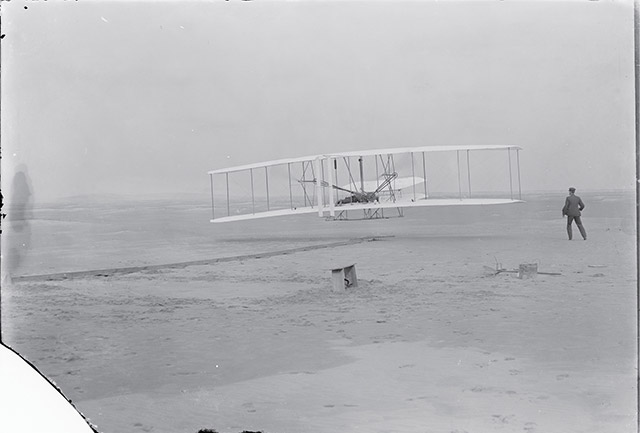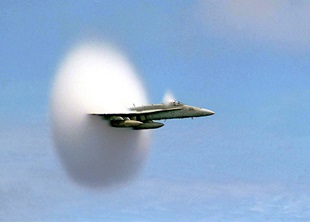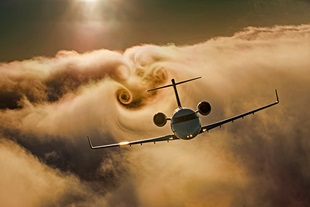In Focus: Iconic Aviation Photos
Eyewitness
Iconic images capture aviation in history
No one personifies the question “Where were you?” more than the photographer, the one on the scene, who saw the event through a viewfinder and pressed the shutter at just the right moment. Click! A moment caught forever for everyone to remember—and for the documentation that proves an event truly happened, as impossible as it sometimes seems.
First flight
Subject: First flight of the Wright Flyer
Date: December 17, 1903
Where: Kill Devil Hill, North Carolina
Photographer: John T. Daniels (image courtesy Library of Congress)
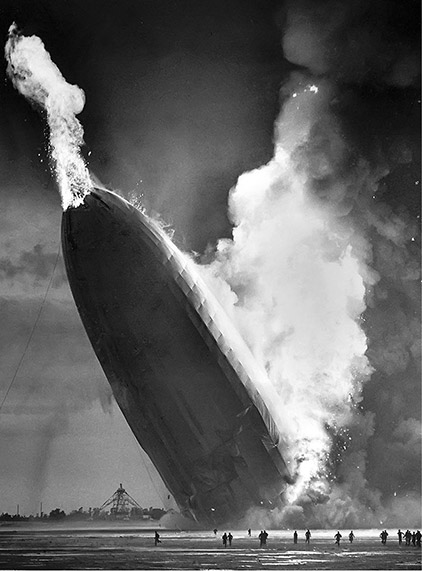
Anything but routine
Murray Becker was a 29-year-old Associated Press photographer fulfilling an obligation to photograph Nazi Germany’s passenger airship as it flew into Lakehurst, New Jersey, on its thirty-seventh crossing of the Atlantic. He and other photographers grumbled about Hitler and this routine assignment on May 6, 1937, when the Hindenburg, attempting to dock, burst into flames. Becker shot 15 photographs with his 4-by-5 Speed Graphic camera in 37 seconds as the horror unfolded. According to his obituary in The New York Times in 1986, “When it was over and his film holders were headed to Newark to be processed, Mr. Becker sat down and wept.” There were 97 people onboard the airship and 35 were killed, including one person on the ground.
Subject: The LZ 129 Hindenburg German airship
Date: May 6, 1937
Where: Lakehurst Naval Air Station, New Jersey
Photographer: Murray Becker, Associated Press
(image courtesy Library of Congress)
‘Lord, take care of me…’
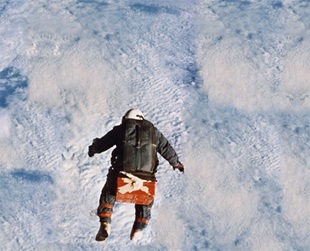 An automatic camera captured Joseph Kittinger leaping into space August 16, 1960, to test a parachute system. Then-Captain Kittinger, a 32-year-old Air Force fighter pilot, climbed in the open gondola of a gas balloon for an hour and a half. Wearing extra clothing and a pressurized suit, he nonetheless lost feeling in his right hand because a tear in his glove exposed it to the extreme cold. Saying a prayer, Kittinger jumped and free fell for 4 minutes and 36 seconds. After the parachute opened, he floated for 10 minutes, landing in the New Mexico desert. His jump stood as the highest skydive for 52 years until 2012, when at the age of 84, Kittinger helped direct Felix Baumgartner’s 24-mile jump.
An automatic camera captured Joseph Kittinger leaping into space August 16, 1960, to test a parachute system. Then-Captain Kittinger, a 32-year-old Air Force fighter pilot, climbed in the open gondola of a gas balloon for an hour and a half. Wearing extra clothing and a pressurized suit, he nonetheless lost feeling in his right hand because a tear in his glove exposed it to the extreme cold. Saying a prayer, Kittinger jumped and free fell for 4 minutes and 36 seconds. After the parachute opened, he floated for 10 minutes, landing in the New Mexico desert. His jump stood as the highest skydive for 52 years until 2012, when at the age of 84, Kittinger helped direct Felix Baumgartner’s 24-mile jump.
Subject: Joe Kittinger
Date: August 16, 1960
Where: 19 miles above Earth
Photographer: An automatic camera (image courtesy of US Air Force)
Shock wave
Capturing the vapor cone that formed around an F/A–18 Hornet off the coast of Pusan, South Korea, U.S. Navy Ensign John Gay said, “I clicked the same time I heard the boom and I knew I had it.” Gay used his personal Nikon 90S. “I put it on full manual,” he said. “I tell young photographers who are into automatic everything, you aren’t going to get that shot on auto. The plane is too fast.” Although Gay’s photo happened the moment the aircraft reached the speed of sound, these mesmerizing cones of water vapor can happen in humid conditions at lesser speeds.
Subject: F/A–18C Hornet
Date: July 7, 1999
Where: Pacific Ocean
Photographer: Ensign John Gay, U.S. Navy (image courtesy of US Navy)
Good morning, Earth
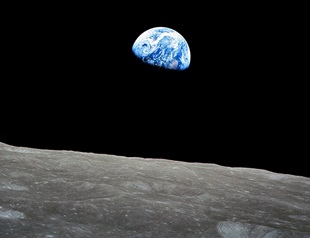
On Christmas Eve in 1968, Apollo 8 was on the first manned mission to orbit the moon. Commander Frank Borman, lunar module pilot William Anders, and command module pilot Jim Lovell reacted to the view:
Anders: Oh, my God! Look at that picture over there! There’s the Earth coming up. Wow, is that pretty.
Borman: Hey, don’t take that, it’s not scheduled (joking).
Anders: (laughs) You got a color film, Jim? Hand me that roll of color quick, would you...
Lovell: Oh, man, that’s great!
Later nature photographer Galen Rowell would say of Earthrise that it is “the most influential environmental photograph ever taken.”
Subject: Earthrise
Date: December 24, 1968
Where: Lunar orbit
Photographer: William Anders (image courtesy of NASA, William Anders)
Swirling vortices
Paul Bowen’s photographs have appeared on more than 1,000 magazine covers over a 30-year career. But he is most famous for his vortices aerials. The Wichita-based aviation photographer says the first instance was a fluke. A magazine art director suggested a photo above the morning fog and, as they descended toward the Pacific Ocean, the vortices appeared. Although Learjet didn’t use that initial set of photos much, the effect caused a sensation when it appeared on the cover of Flying magazine sometime later—with a Cessna Citation. Sometimes the effect works, sometimes it doesn’t, Bowen says, and he’s never sure when or if it will.
Subject: Learjet 60
Date: 2004
Where: Lake Tahoe, Nevada
Photographer: Paul Bowen
At home on the range
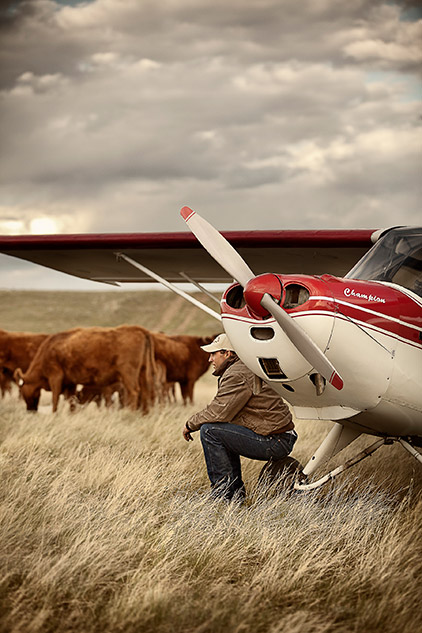
To launch the AOPA Pilot series “General Aviation Serves America,” photographer Mike Fizer and author Alton K. Marsh traveled to northeastern Montana where they met with rancher Travis Nelson. Nelson’s 1958 Aeronca Champ—which he calls the Cowboy Cadillac—was a natural to illustrate pilots and aircraft at work. “I remember thinking, My God, this is the shot,” Fizer said. Fizer was about 100 feet from Nelson, who was initially standing at the airplane. “I yelled at him to sit down and he just did so naturally.” Fizer took the shot with his Canon FD Mark III camera at F2.8 and it all “just fell together.”
Subject: Rancher Travis Nelson and his 1958 Aeronca Champ
Date: May 21, 2009
Where: 20 miles south of Opheim, Montana
Photographer: Mike Fizer

